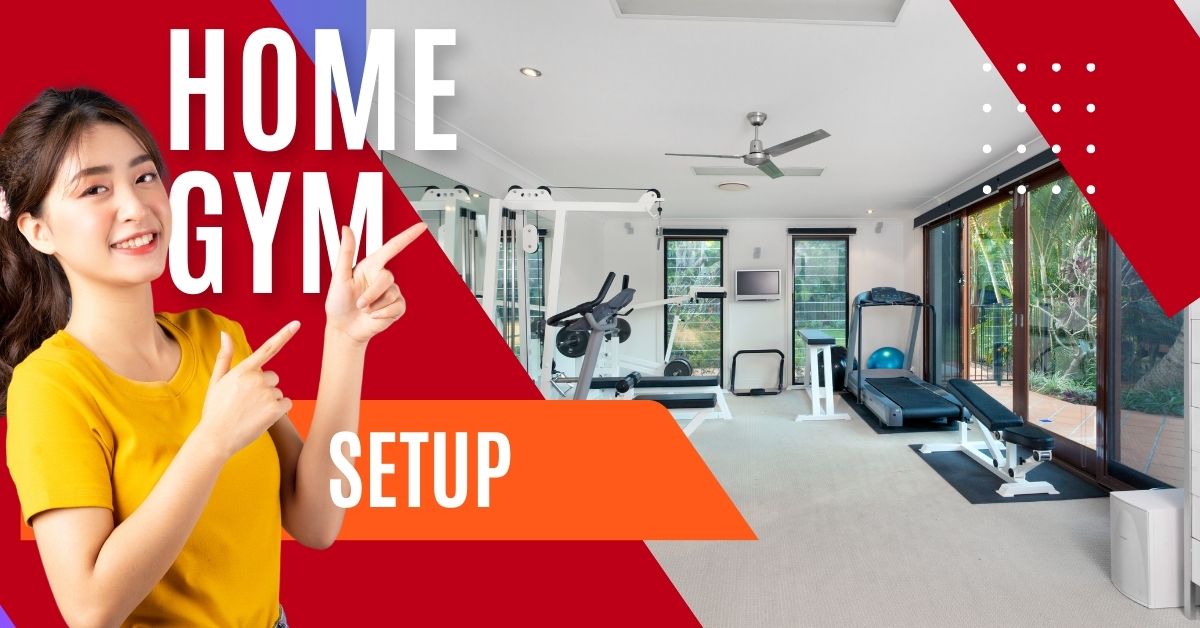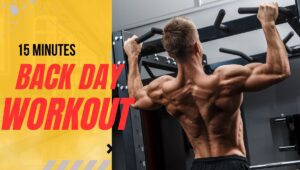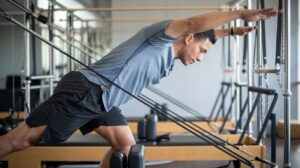Table of Contents
Toggle1. Introduction:
Building a gym at home is one of the best investments you can make for your health and fitness, including lifestyle. There are no more lines to wait for equipment at the busy gym or traveling to the other part of town – with a proper home gym setup in place, guidelines dedicated to you can be done whenever you wish. Whether you are a professional sportsperson or an individual willing to mark the beginning of your fitness path, having appropriate space designed for your needs matters a lot.
This manual will provide you with 7 important tips that are the best in helping you create a perfect home gym that will motivate you and help you in your workouts rather than ignoring them. While choosing the proper equipment or increasing safety and comfort, these particularly cater to all expenses or all spaces so that the home gym built will comply with all the requirements and make you desire to work more.
2. Assessing Your Space and Goals:
Before diving into equipment purchases or deciding on gym decor, assessing your available space and defining your fitness goals is important. A well-thought-out approach will ensure your home gym is efficient, functional, and tailored to your needs.
Analyzing Your Available Space:
The first step in creating your home gym is determining where it will go. Whether you have a spacious basement, a spare room, or just a corner in your living room, your gym setup should maximize your space. Consider the following factors when analyzing your space.
Available Square Footage: Measure your space to get a clear understanding of how much room you have to work with. Even a small area can be transformed into an effective workout space with the right planning.
Ceiling Height: If you’re into activities like jumping or using equipment like a pull-up bar, check your ceiling height to ensure there’s enough room for full movement.
Floor Surface: Hardwood floors, carpets, and tiles all offer different workout experiences. While hard surfaces may be fine for lifting weights, softer flooring is ideal for yoga or floor exercises.
Multipurpose Spaces: If you don’t have a dedicated room for your gym, think about how to share your space creatively. A living room or garage can double as a gym with foldable or compact equipment that’s easy to store.
Defining Your Fitness Goals:
Your fitness goals should directly influence your home gym setup. Are you focused on strength training, cardio, flexibility, or a combination of all three? Your goals will dictate the kind of equipment and layout you’ll need.
Strength Training Goals: If your main objective is to build muscle or increase strength, prioritize equipment like dumbbells, kettlebells, and a weight bench. Consider multifunctional machines or racks if you have the space.
Cardio Focus: For cardio enthusiasts, space-saving treadmills, stationary bikes, or compact rowing machines are ideal. Smaller spaces might benefit from resistance bands or jump ropes.
Flexibility and Mobility: If yoga, Pilates, or stretching is your priority, focus on having an open area for floor exercises, a quality yoga mat, and props like blocks or straps.
Multi-discipline Fitness: If you’re aiming for a balanced routine that combines cardio, strength, and flexibility, plan your gym layout to allow for different workout stations, with enough open space to move freely between exercises.
By tailoring your home gym to your fitness goals and the space available, you can ensure that it will be a place where you feel comfortable and motivated to work out. The clearer you are about your goals, the easier it will be to choose the right equipment and create a space that works for you.
3. Selecting the Right Equipment:
Once you’ve assessed your space and established your fitness goals, the next step is selecting the right equipment. The equipment you choose will depend on your workout style, available space, and budget. Whether you’re building a minimalist gym with just the essentials or a fully equipped workout haven, selecting the right pieces can make all the difference.
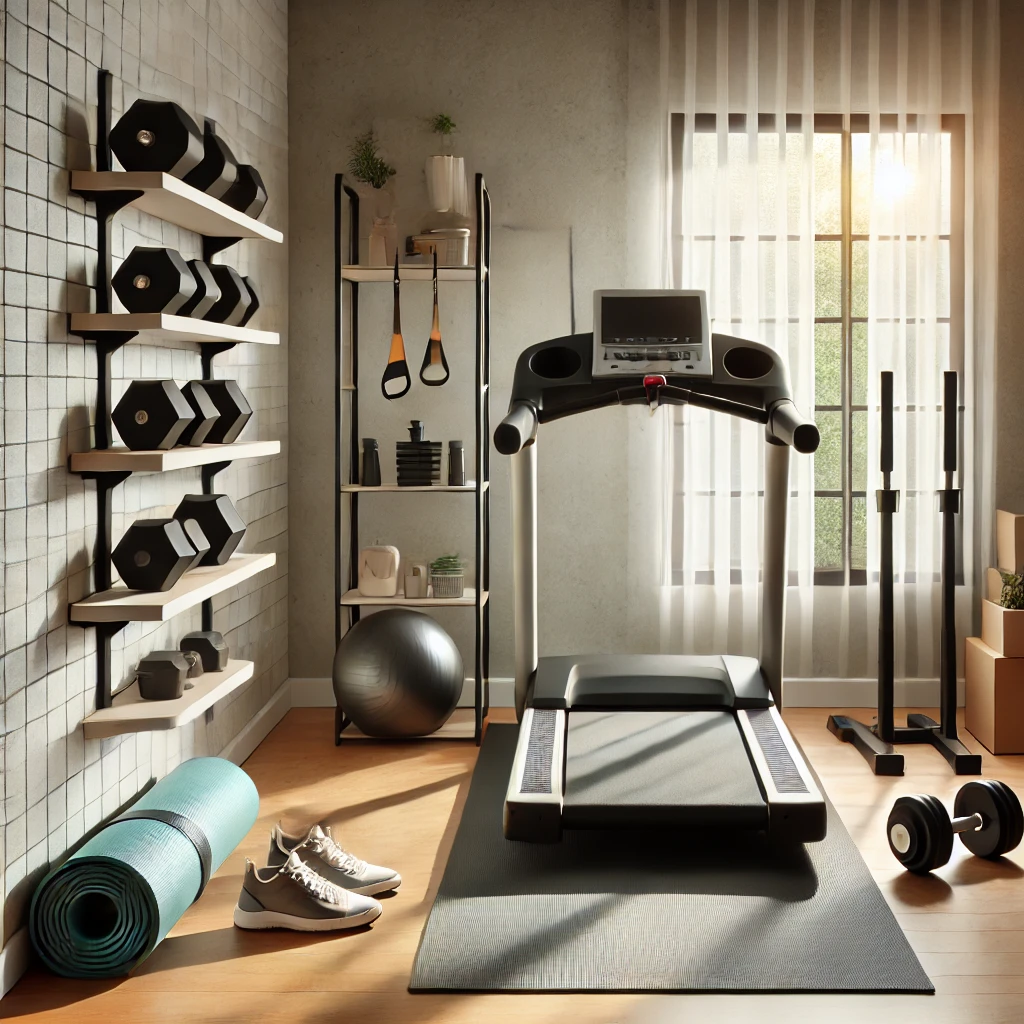
Must-Have Equipment for Every Home Gym:
There are a few core pieces of equipment that are versatile enough to fit into almost any home gym setup, regardless of your fitness level or goals. Here are some essentials that provide a full-body workout while occupying minimal space:
- Dumbbells or Adjustable Weights: Dumbbells are a must for strength training. Adjustable weights are especially space-efficient, allowing you to swap out different weight plates depending on the exercise.
- Resistance Bands: Affordable and highly versatile, resistance bands are perfect for strength training, stretching, and even physical therapy. They’re lightweight, easy to store, and can provide a challenging workout for all levels.
- Yoga Mat: A high-quality mat is essential for floor exercises, yoga, and stretching routines. It’s the foundation for many exercises and offers comfort and support.
- Jump Rope: A simple jump rope can provide a quick and intense cardio workout, making it a great addition to small spaces.
- Stability Ball: This piece is excellent for core exercises, improving balance, and even as an alternative to a bench for strength training.
- Pull-up Bar: If you have the space and the ceiling height, a pull-up bar is a fantastic addition for building upper body strength. Many pull-up bars are designed to fit over door frames, making them easy to install without taking up much room.
Choosing Equipment Based on Your Workout Style:
Not every workout is the same, so your equipment should reflect the type of exercise you enjoy. Tailoring your setup to your preferences will ensure that you get the most out of your home gym.
- For Cardio Lovers: If cardio is your go-to workout, investing in a treadmill, stationary bike, or rowing machine is key. For smaller spaces, consider foldable models or compact equipment like a mini stepper or pedal exerciser.
- For Strength Trainers: If you’re focused on strength, you’ll want to include kettlebells, dumbbells, or even a barbell and weight plates if you have the space. For a more compact option, resistance bands can be just as effective for building strength without the bulk of heavy equipment.
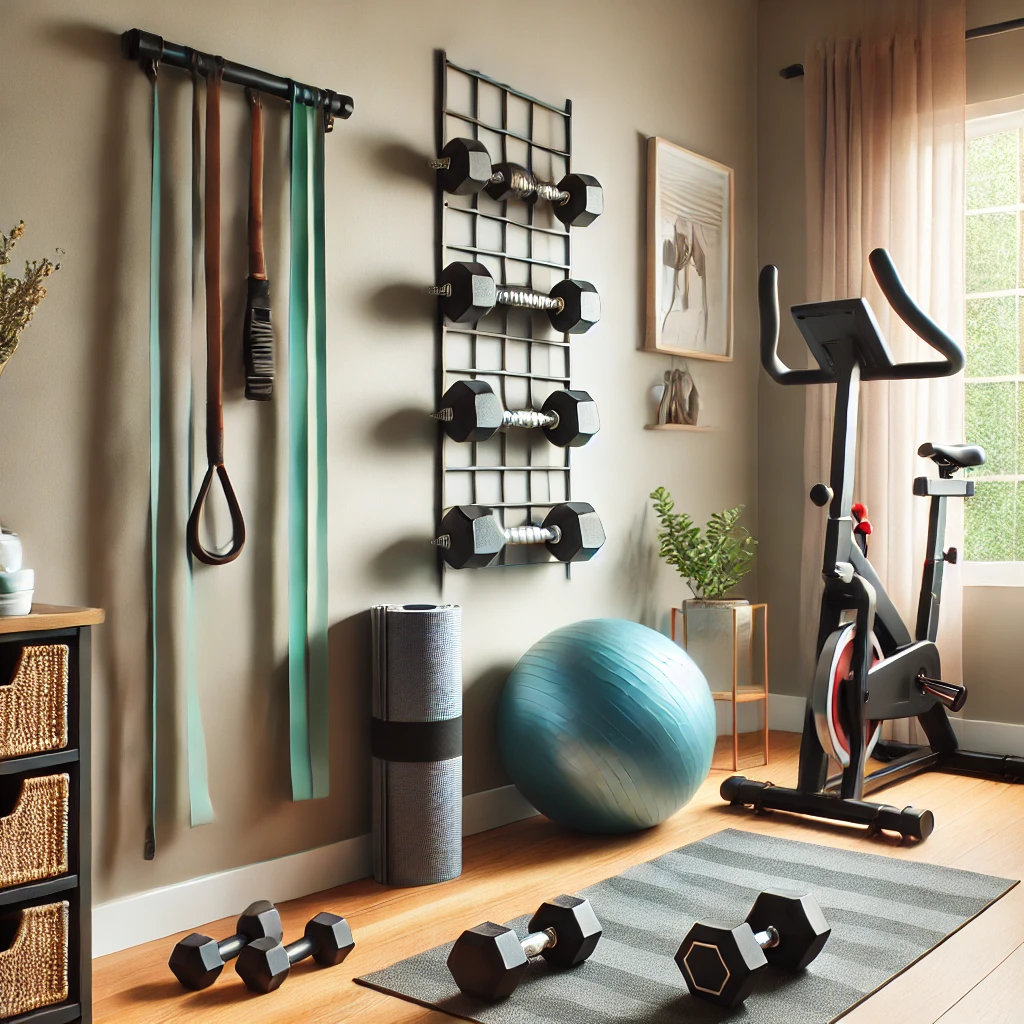

- For Flexibility and Mobility: If stretching, yoga, or Pilates is more your speed, prioritize equipment like a foam roller, yoga blocks, and a strap for deep stretches. Consider a reformer if you’re dedicated to Pilates and have enough space.
- For HIIT and Circuit Training: High-intensity interval Training (HIIT) requires equipment that can handle quick transitions. Adjustable weights, a jump rope, and a plyometric box are great for fast-paced workouts, while resistance bands and medicine balls can enhance circuit training sessions.
- By choosing equipment that aligns with your workout style, you’ll create a gym space that makes working out enjoyable and effective. Whether you’re lifting weights, practicing yoga, or breaking a sweat with cardio, having the right tools is crucial to your fitness success.
4. Budgeting for Your Home Gym:
Creating the perfect home gym doesn’t have to break the bank. While it’s tempting to go all out with the latest high-tech equipment, a well-planned budget will help you get the most value without overspending. This section will help you figure out how to set a realistic budget and explore affordable alternatives that won’t sacrifice the quality of your workouts.
Setting a Realistic Budget:
Before you start purchasing equipment, it’s important to set a clear budget for your home gym setup. Consider these factors when determining how much you’re willing to spend:
Total Available Space: If you’re working with a larger space, you might need more equipment or a larger variety, which could increase the cost. However, if you have a small space, you can focus on a few key pieces, keeping costs lower.
Fitness Goals: Your budget should reflect your fitness goals. For example, if you’re a serious weightlifter, investing in a quality set of dumbbells or a barbell set is essential, whereas yoga practitioners may only need a mat and a few props.
Frequency of Use: If you plan on using your home gym regularly, it might be worth investing a bit more upfront on durable, higher-quality equipment. If you only plan to work out occasionally, you can stick to the basics.
Once you’ve established a budget, make a list of the essential items and prioritize them. Consider starting with foundational equipment (like dumbbells or a yoga mat) and gradually building up your gym over time as your budget allows.
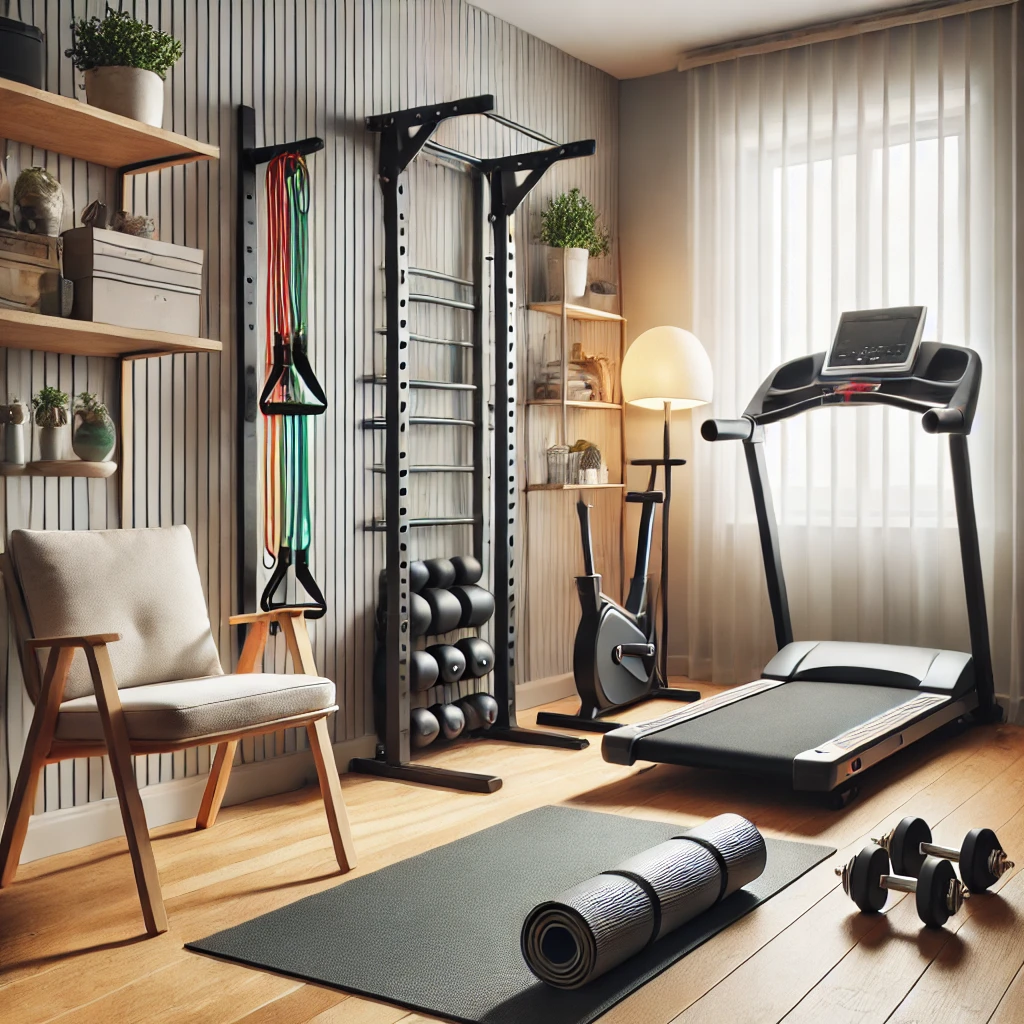

Affordable Alternatives for Gym Equipment:
If you’re working with a limited budget, there are plenty of ways to save money while still creating an effective workout space. Here are some budget-friendly tips to consider:
Buy Secondhand Equipment: You can often find great deals on used fitness equipment through online marketplaces or local listings. Many people sell barely-used items like treadmills, ellipticals, or weight sets at a fraction of the cost.
Opt for Multifunctional Equipment: To save both space and money, choose equipment that serves multiple purposes. For example, adjustable dumbbells allow you to vary the weight without needing a full set, while a bench with multiple incline settings can be used for various exercises.
DIY Solutions: For some items, a little creativity can go a long way. A sturdy chair can substitute for a workout bench, and a homemade sandbag or water-filled jugs can work as weightlifting tools. Resistance bands can replace some machines or weights while taking up almost no space.
Look for Sales and Discounts: Fitness equipment retailers often offer seasonal sales, so keep an eye out for discounts during holidays or end-of-year clearance events. Some brands also offer financing options for larger purchases.
Start Small and Build Over Time: You don’t need to buy everything all at once. Start with a few essential pieces and slowly add to your collection as your budget allows. Prioritize items that will give you the most variety in your workouts, like resistance bands or adjustable dumbbells, before moving on to bigger investments.
By approaching your home gym setup with a smart budget in mind and looking for ways to save, you can create an effective workout space that meets your needs without draining your bank account.
4. Maximizing Comfort and Safety:
While equipment is essential, creating a comfortable and safe workout environment is just as important. Your home gym should be a place where you can move freely and exercise without risk of injury. By paying attention to factors like flooring, ventilation, and lighting, you can enhance both comfort and safety.
Flooring Options for a Safe Workout Space
The type of flooring you choose can make a big difference in the comfort of your home gym, as well as help protect both your joints and your equipment. Here are some flooring options to consider:
Rubber Flooring: This is the gold standard for home gyms, offering excellent cushioning, sound absorption, and durability. Rubber flooring is perfect for high-impact exercises and weightlifting because it protects the floor and reduces noise from dropped weights.
Foam Mats: Foam mats are a more affordable option that provides decent cushioning, especially for activities like yoga, Pilates, or bodyweight exercises. They can be purchased in interlocking squares, making them easy to install in any size space.
Carpet: If you already have carpeting, you might not need additional flooring. However, it’s not ideal for high-intensity or heavy weightlifting, as it can trap moisture and get damaged over time.
Vinyl Flooring: Durable and easy to clean, vinyl is a good option for multi-use spaces. It can handle most types of workouts but may not provide the same level of impact absorption as rubber or foam.
Selecting the right flooring for your home gym will depend on your workout style and budget, but in general, you want something that offers support and protection.
Ensuring Proper Ventilation and Lighting:
Good ventilation and lighting are often overlooked but crucial components of a comfortable workout space.
Ventilation: Ensuring your gym has proper air circulation is important to avoid stuffiness and keep the room at a comfortable temperature. If your gym is in a basement or garage, consider installing a fan or portable air conditioner to keep the air moving. If possible, set up your gym near a window that can be opened for fresh air.
Lighting: Good lighting is very important for creating a welcoming and energizing atmosphere and reducing eye strain. Natural light is best, so position your gym near windows if possible. For indoor or darker spaces, install bright overhead lights or floor lamps to make sure the room is well-lit. Dimly lit spaces can affect your mood and motivation, so opt for lighting that energizes your space.
By focusing on these comfort and safety factors, you’ll create a home gym that’s not only functional but also enjoyable to use. When your space feels good to work out in, you’re more likely to stick to your routine and avoid injuries.
5. Designing for Motivation:
An important part of maintaining a consistent workout routine is staying motivated and creating an environment that supports your goals. is staying motivated, and your home gym’s design can play a big role in this. By creating a space that energizes and inspires you, you’ll be more likely to stick to your fitness goals. From motivational decor to a visually clear workout plan, these design tips will help you create a gym that keeps you moving.
Creating a Motivational Atmosphere:
The atmosphere of your home gym can directly impact your workout performance and enthusiasm. Here are some ways to make the space more motivational:
Add Mirrors: Installing a large mirror or a series of smaller mirrors can make your home gym feel larger and brighter. More importantly, mirrors allow you to check your form during exercises, helping to prevent injuries and improve performance.
Decorate with Inspirational Quotes: Placing posters or wall art featuring motivational quotes or images can help boost your energy and focus during workouts. Whether it’s a quote that resonates with your goals or an image that inspires you, this small touch can make a big difference.
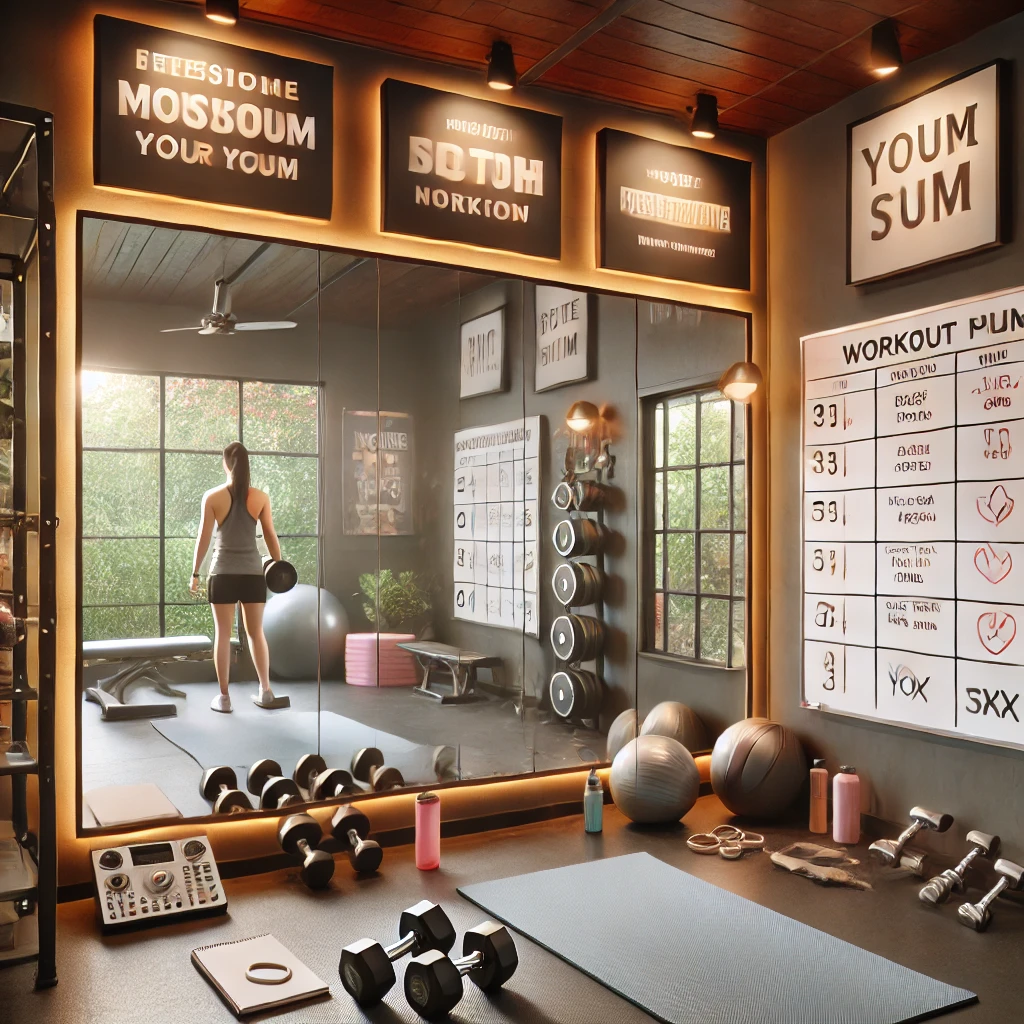

Play Music or Videos: If you enjoy working out to music or following video workouts, set up a sound system or wall-mounted TV in your gym. Music can boost your mood and energy, while workout videos provide structure and guidance during sessions.
Setting Up a Visual Workout Plan:
A clear visual representation of your workout routine can keep you on track and motivated to reach your goals. There are several ways to integrate a visual workout plan into your gym setup:
Whiteboard or Chalkboard: Install a whiteboard or chalkboard on the wall where you can write down your weekly workout plan. It’s a simple way to stay organized and ensure you’re following a balanced routine.
Workout App on Display: If you use fitness apps to guide your workouts, consider mounting a tablet or smartphone holder on the wall where you can easily view your workout schedule, videos, or progress.
Progress Tracking Chart: Keeping a visual chart of your fitness progress — whether it’s tracking weight, reps, or running distance — can be incredibly motivating. Watching your progress grow over time reinforces the hard work you’re putting in.
By designing your home gym to be a space that encourages you to stay consistent, you’ll make it easier to get excited about your workouts. Motivation is the most important thing to any fitness journey, and with a well-designed gym, You’ll have everything you need to stay focused and fully engaged in your fitness routine.
6. Conclusion:
Setting up a home gym is an exciting and empowering way to take control of your fitness journey. Whether you have a large or small space, a big budget, or a tight one, there are endless possibilities to create a gym that’s functional, motivating, and suited to your workout style. By following these 7 essential tips, you can ensure your home gym setup boosts your workouts and helps you reach your fitness goals faster.
7. FAQS:
How much space do I need for a home gym?
You can create an effective home gym in as little as 50 square feet. Small spaces can work well with compact equipment like resistance bands and dumbbells.
What are the essential pieces of equipment for a home gym?
Dumbbells, resistance bands, a yoga mat, and a jump rope are versatile essentials for any home gym, covering strength, cardio, and flexibility workouts.
How do I make a home gym on a budget?
Start small with affordable equipment, such as resistance bands and used gear. You can gradually add more equipment as your budget allows.
What type of flooring is best for a home gym?
Rubber flooring is ideal for its durability, shock absorption, and noise reduction. Foam mats are also a budget-friendly and versatile option.
How do I make my home gym safe?
Ensure proper ventilation, good lighting, and non-slip flooring. Use equipment correctly and check your space for potential hazards like loose weights.

